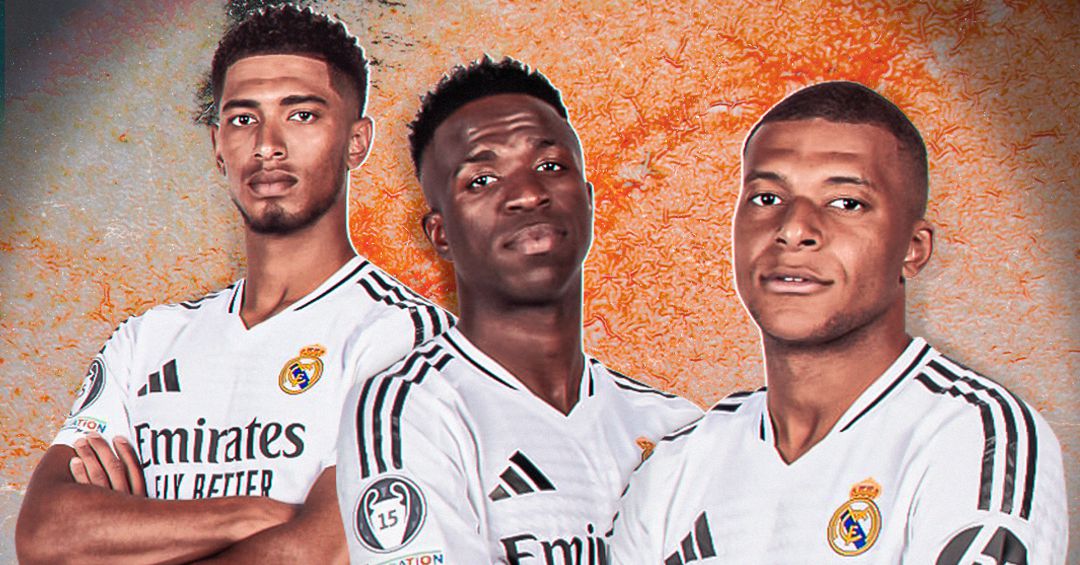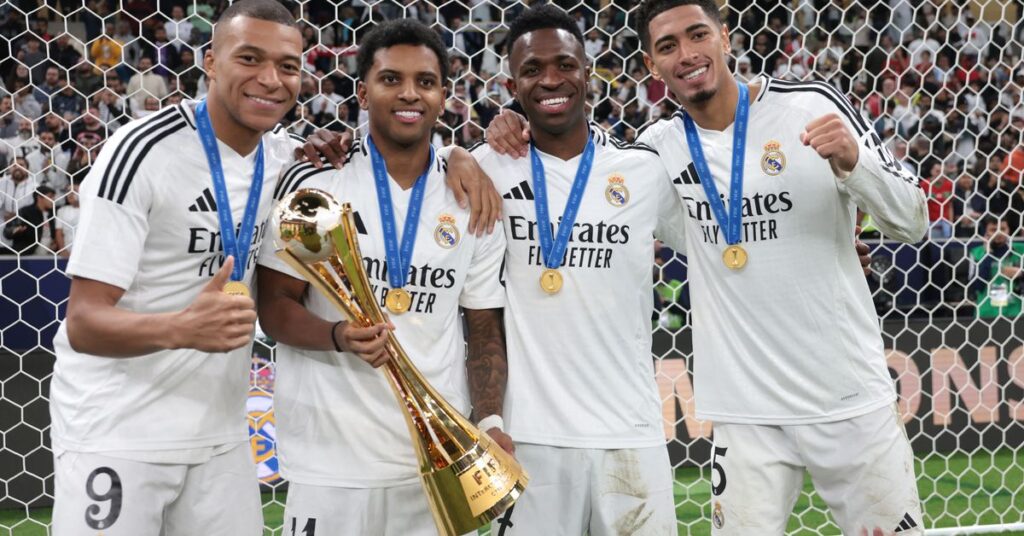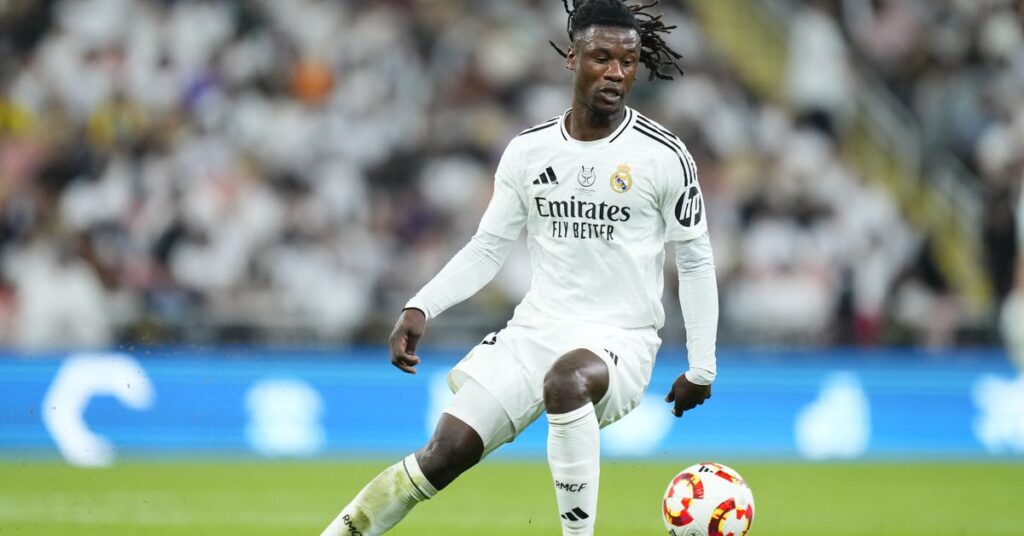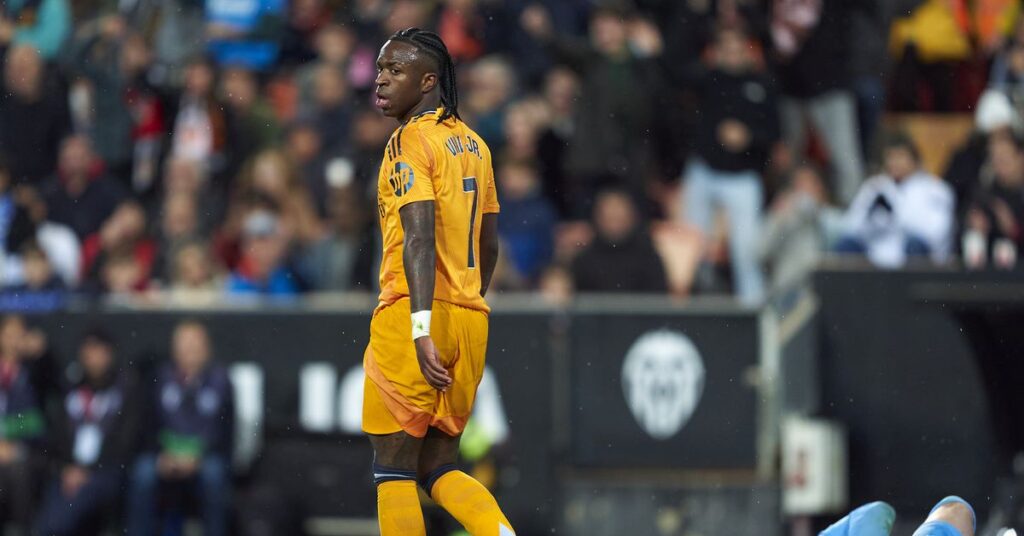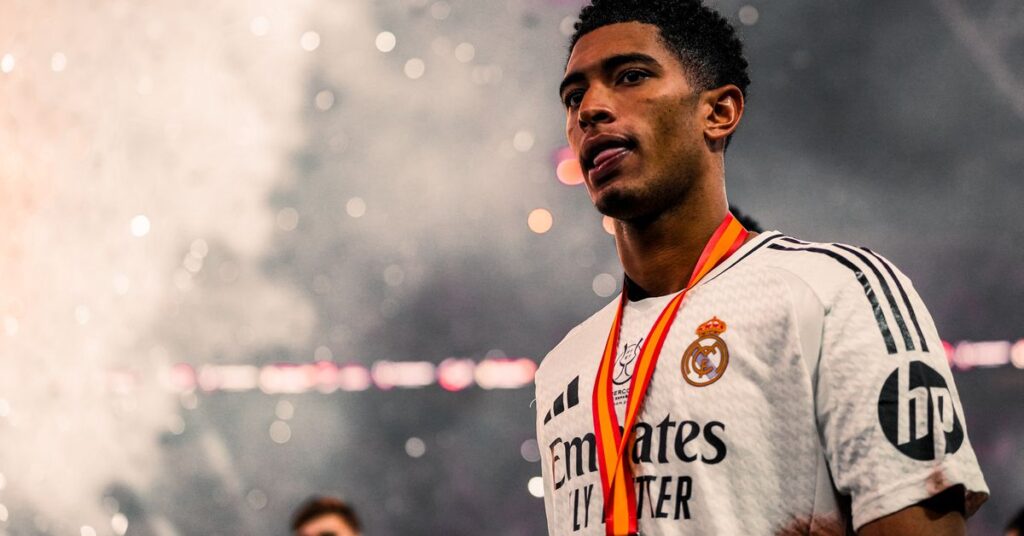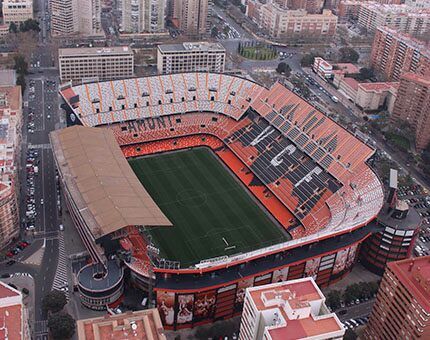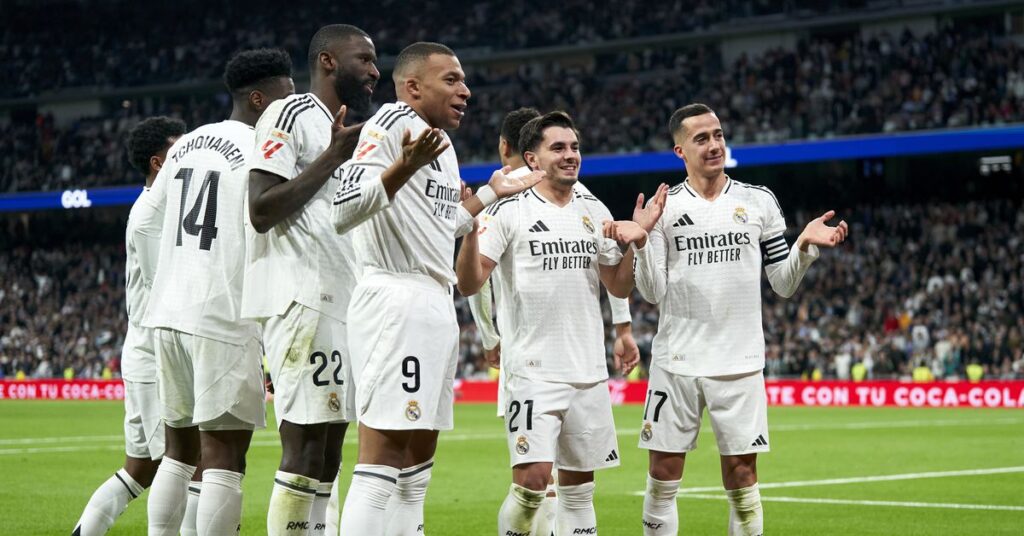These observations — where I look at Real Madrid’s history, its players on loan, Castilla, tactical tidbits, and other relevant thoughts — are now a regular thing. All previous editions can be found here.
Time to jump in to this month’s observations column, where we dive into some of Real Madrid’s tactical problems.
Defensively aloof
We’re really all just old men yelling at clouds, ageing day by day, begging Real Madrid to stop pressing (for reasons that should be clear by now).
But it’s not just their random pressing sequences that inflict self-harm. Even in more “organized”, slower tempo defensive stances, the team is aloof.
A lot of the self-damage is done by not tracking runners in the box. It’s hard to single out any one individual, because everyone in the team takes turns doing it throughout the season. Players jog back, praying the attacker doesn’t punish their lack of tracking.
Other times, they are completely standoffish to their surrounding opponents:
The above sequence barely requires heavy tracking — just awareness. Pedri, Gavi, and Lewandowski are allowed to roam freely between the lines. Fede Valverde and Eduardo Camavinga don’t register the off-ball runs. The team is broken by any semi-decent off-ball movement by opponents. It’s jarring how badly the team is defending regardless of their approach: Low-block, mid-block, aggressive high-pressing. Real Madrid’s defense is in shambles.
Sludgy, quicksand offense
Real Madrid are too talented to labour as badly as they do progressing the ball. I understand Toni Kroos no longer plays football and that the team’s defense has fallen off a cliff with the withering depth chart — but there’s no way a team with this much talent in the front-six should struggle this much against every good team they come up against.
When teams implement a man-to-man high press against Real Madrid, the build-up is clunky, disjointed — with little-to-no flow or clear-cut plan to escape pressure. The third-man runs remain at a bare minimum, and it’s usually on Jude Bellignham taking individual initiative — but he can’t be in three places at once. Getting the ball to either Lucas Vazquez or Ferland Mendy is basically a giveaway death trap. It doesn’t get much better if the ball is at the feet of Aurelien Tchouameni. Thibaut Courtois almost never has any hope of hitting an open outlet:
There used to be a time where Real Madrid would bait a press. It would be the best way to break free and find open water — those days are long gone. More press-resistant full-backs would help, but there are deeper issues in the team’s spacing and off-ball movement. The stagnancy makes it easy for teams to match Real Madrid mano-a-mano.
Lucas Vazquez, a consistent match-up problem
Lucas Vazquez is a perfect squad player. There should be no complaints about a player who, himself, never complains. He’s here to serve, to do what’s asked, to be reliable, to take a lesser role than he would at another team because he loves it here. Real Madrid always needs a Lucas Vazquez. Every team needs a Lucas Vazquez.
But if Lucas Vazquez is your primary right-back from now until June, you’re in trouble. He is a good depth chart filler. If he’s the only solution, with no back-up behind him in sight (apart from make-shift cameos from Fede Valverde, Raul Asencio, or whoever else), you’re going to run into trouble:
Vazquez struggles both physically and on a technical level on defense. His work ethic is rarely — if ever — in question. But cutters into the box can dunk on him with a header at the far post, and teams often channel their play on his side, getting their left wingers to go at him consistently.
They are correct in pin-pointing that side as a Real Madrid weakness. Vazquez struggles against athletic dribblers. Randy Nteka was a huge pain-point for the Spaniard from the above game against Rayo Vallecano. In other games, it’s been Ademola Lookman, Luis Rioja, Raphinha, or even Pachuca’s Oussama Idrissi.
Real Madrid should look at their options at right-back. If not in the winter market, serious consideration should be given to either Lorenzo Aguado or Jesus Fortea to get involved.
Are we talking about Brahim Diaz enough?
Brahim currently boasts the most goal-creating actions per 90 in La Liga (1.33) — a mark that puts him second in the Big Five Leagues.
He might be the team’s most underrated player. He doesn’t start, but puts on a clinic in his minutes — mostly off the bench where he comes in and flips games upside down.
He is playing insane defense:
Are we talking about Brahim enough? Huge impact in minutes he’s playing — mostly off the bench. 1st in La Liga in shot-creating actions; a mark that puts him 2nd in Big 5 leagues.
Pro-active attacker. Working himself into the ground on defense.pic.twitter.com/7rfWGi1KWJ
— Kiyan Sobhani (@KiyanSo) January 6, 2025
His control in tight spaces, in traffic, is — and has been all season — stupefying:
Brahim runs, ceaselessly. He is a brilliant quick thinker in transition, and has an entire toolbox filled with savvy offensive tricks consisting off dinked through-balls into the box, the ability to dribble through several players with his low center-of-gravity, and well-placed finishes into the corners of the net from close and long range.
Any surge in the second half of the season that Real Madrid puts together will likely involve Brahim Diaz off the bench. He is akin to the previous bench-mob players like Rodrygo and Eduardo Camavinga in the 2022 Champions League title run.
Raul Asencio, out of nowhere, bullying attackers
Raul Asencio was good with Real Madrid Castilla — but not this good. It is a common phenomena: Young players who are good in the youth ranks, but not prodigal, level up at the senior level with better players around them. Asencio has impressed even the most avid Castilla watchers who weren’t that high on him.
Asencio has been a revelation, so much so that he’s made the board turn a blind eye to signing an emergency center-back. His ball progression has been phenomenal. He escapes pressure with strong ball carrying and is hard to muscle off the ball. He carries all 1.84 meters of himself like a seasoned vet.
While playing well in his early cameos, the big litmus test came against a scorching LIverpool at Anfield. Asencio looked unbothered by the occasion despite the loss.
Two games later against Athletic Club in Sam Mames, Asensio covered a lot of ground, cleared crosses (though could’ve dealt better with one in particular that led to an Athletic goal), and covered well on both flanks. His 1v1 defending against Iñaki Williams was terrific:
Writing about Asencio. Impressive how quickly he picked things up at pro level. Few mistakes here and there, normal. Carries himself like a 27-year-old vet. Hard to muscle off the ball. Strong ball-carrier. Great read on the game defensively. pic.twitter.com/if0Ei5pTJu
— Kiyan Sobhani (@KiyanSo) December 18, 2024
He’ll come over to either side of the field to make sure he’s first to 50/50 balls being swung into the box:
Asencio may have lost minutes with Aurelien Tchouameni’s return, but his play has been highly encouraging. Real Madrid have, truly, a proper player in the backline with him, and based on merit, he should be a starter.
Dani Ceballos, hunting on both ends
Last season, in the games where neither Toni Kroos nor Luka Modric were on the field, we were begging for Dani Ceballos to deputize. He isn’t either of those unicorns, but he has the ability to progress the ball while fighting hard on defense.
Over time, Ceballos became a bit of a running joke among fans, but it’s hard to argue with his performances this season. Over the years, there have been stretches where Ceballos has reminded us of how good he is — of how promising he was in his early days at Real Betis.
Two seasons ago, Ceballos slung the sixth most progressive passes in La Liga and the fifth most passes into the final third. This season, Ceballos has looked great. In the post Toni Kroos era (drink!), Ceballos can help fill the void from that position:
Ceballos fits the profile, and timeline, of Real Madrid’s desired prototypical midfielder: versatile enough to toggle through three-four positions. Primarily an 8, Ceballos can drop into the deep quarter-back role to in the build-up phase, he can counter-press and play through balls in the final third. His work-rate on defense make him a reliable player on both ends.
Ceballos can still improve with his tracking on defense. Almost every Real Madrid player needs to improve in that regard.
Once seen as ‘overkill’ in midfield, Ceballos is a valuable contributor to a squad decimated with injuries. From the club’s perspective, that contract extension sure looks like a great idea now.
Camavinga, in and out, growing pains
There are so many things going on this season — so many injuries, so many distractions — that we didn’t really have time to think about the ramifications of Eduardo Camavinga barely being available this season.
Camavinga played just nine out of the first 22 games this season due to injuries. The team missed him. He had just returned from a knee injury in September, started to find his feet, then took off injured at Anfield. He was good even in bloodbath losses against Barcelona in October and Liverpool. The team spiralled without him when he was taken off.
Camavinga is one of the most unsuspecting ball-winners in Europe. He gets a toe in to thieve the ball away from an attacker who thinks he’s free. He slides in for his signature CobraTackle™ on players who have no idea he’s even hovering.
But there are games and moments that remind Ancelotti why he doesn’t have him in the same circle of locked-in starters like Valverde, Bellingham, Vinicius, and Mbappe. He can fall asleep on defense, and then compensate for it with a late challenge (see: Most recently in Super Cup Final blowout vs Barcelona).
But we should be fair: Camavinga shows up in almost every Clasico and big game, and almost everyone was bad against Barcelona in a team set-up to fail.
Camavinga is multi-faceted, all impactful. He has been the team’s best single-pivot for a good part of the past 12 months. He also reads the game well as an 8. He has been graceful evading aggressive pressure:
Camavinga’s biggest problem right now is durability and availability. He will polish some of the poor decisions with experience.
On Vinicius, Mbappe, offense, and Real Madrid’s Champions League run
Through six Champions League games, Real Madrid have scored 12 goals — fewer than four other teams — while their defense has leaked an xGA of 13.1, which is worse than everyone apart from four teams, all basement dwellers: Young Boys, Slovan Bratislava, Red Star, RB Salzburg.
It’s been poor. If you’re an optimist, you’ll say: The team hasn’t peaked yet, and Kylian Mbappe is finally starting to get going.
The eye test has been underwhelming, though. Real Madrid’s games in the Champions League haven’t erred on the side of dropping points while being unlucky — every game they’ve played in the competition (apart from the second half against Borussia Dortmund) has looked troubling.
The stretch without Vinicius got off to a rocky start after the Anfield and San Mames debacles. With Vinicius, there was little to get excited about in terms of the synergy between him and Mbappe, but it got exponentially worse without him when he was sidelined.
Perhaps the chemistry between the two is slowly improving, but the signs are very gradual and non-seismic to have seen a positive trend emerging. Against Barcelona, they all looked isolated. Mbappe, individually, looked great — but he was asked to single-handedly pull moments of genius from his, erm, behind.
The connection between Vinicius and Mbappe still has redundant movements, where they operate so close to each other that they almost take the ball off of each other’s feet.
The hope was that Mbappe’s arrival would free up space for Vinicius — that he would drag defenders away. It seems congested.
If Real Madrid are to succeed this season, they will need a more synergistic offense.
Jude Bellingham, 1st touch out of pressure
Every week there’s a new thing about Jude Bellingham to marvel at. What will it be this week? His defense in transition? His three lungs? His covering for the full-backs? Crashing the box?
Selling it short. There’s a long list. It’s rare we don’t see him showcase the entire package in a given performance. He is Alfredo di Bellingham for a reason.
One thing we’ll always see with him, regardless of where he is on the pitch on any given sequence, is his artful touch out of pressure. Sometimes the play requires a roulette, or four or five touches to bring the ball under control before he evades. Sometimes it’s the minimal effective dose: one touch, one shoulder drop:
It’s possibly an unpopular opinion, but Bellingham is the closest thing Real Madrid have to Toni Kroos in terms of press-resistancy and ‘pausa’. (With the obvious caveat that no one will ever be Toni Kroos. ‘Closest’ is a hell of a compliment.)
Kroos was a master of taking the right first touch out of pressure:
Bellingham is silky and efficient in the build-up phase. Any line-ups without him will suffer getting the ball up the field reliably and consistently, especially against high-pressing teams.
Few balance that on-ball importance with high-flying defense. Bellingham is in the 90th percentile or above in tackles, interceptions, and blocks among attacking midfielders. He is a serious aerial presence.
Not that it matters too much, but those not watching Real Madrid (‘casuals’ to put it politely) will not realize how great Bellingham has been this season because his numbers are down (though the numbers are trending up again). But he’s been, um, absolutely unbelievable.

 Workout
Workout
 Meditation
Meditation





 Contact Us
Contact Us
